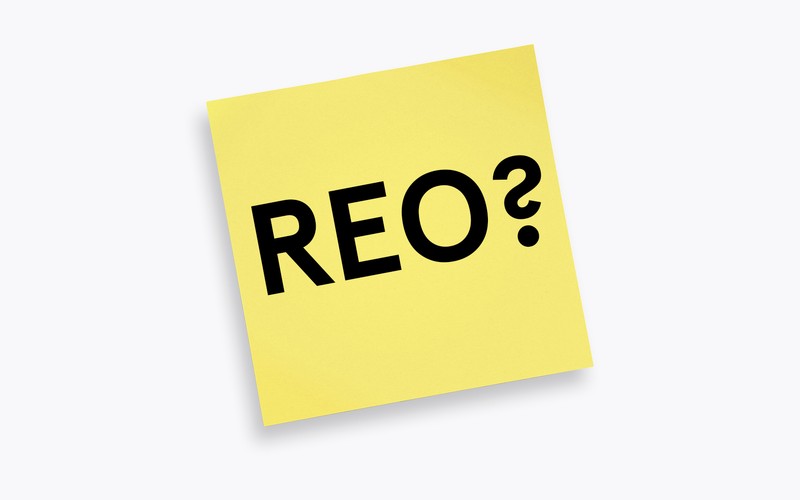If you have been working in real estate as an investor or seeking to buy an affordable home, then you have likely encountered the term REO. Standing for real estate owned, these kinds of properties are high-risk for buyers, but the trade-off is the potential for big rewards in after-repair value.
What about buying REO properties makes them risky for real estate investors and homebuyers? How do you mitigate that risk? And are the benefits of buying REO worth it? Let’s dive into REO real estate and share all you need to know about these real estate listings.
What is REO?
Real estate owned (REO) is a term used to describe a property that did not sell at a foreclosure auction that a lender or bank now owns.
The previous owners defaulted on their mortgage loan payments, resulting in the lender taking possession of it. But lenders are in the business of lending money, not owning properties, so they don’t want to hang onto them. They put these properties up for sale listed as bank-owned or REO properties.
Any lender or mortgage investor can carry real estate-owned properties from traditional banks, government agencies like Freddie Mac and Fannie Mae, and non-traditional lenders.
To get a handle on REO, we’ve got to understand how the lender took ownership of the property.
How does foreclosure work–and why did the property fail to sell?
Foreclosure happens when a homeowner can no longer make their mortgage payments. In lieu of foreclosure, the owner can attempt to refinance with their lender or try a short sale. If they can’t find a buyer or negotiate the right terms with the lender, it moves on in the repossession process.
The process begins when the homeowner falls delinquent, typically after they miss 3-6 months of mortgage payments.
After months of nonpayment, the lender will send a demand letter giving the borrower a certain amount of time–usually 30 days–to bring their payments current or face foreclosure.
Foreclosure is a legal process where the lender takes possession of the property and evicts the homeowners. The lender or their representative files a petition with the courts to officially get the foreclosure underway. The process can last from a few months to over a year, depending on the state laws where the property is located.
The property is put up for a foreclosure sale, usually at a public auction. Anyone can bid on the property, including the lender, who places a “credit bid.” Essentially a lien, this bid combines the amount of money owed on the loan, foreclosure fees, and other costs. You may also see the term “specified bid,” which means the lender’s opening bid is less than what it is owed. A “full debt bid” signals that the homeowner has equity in the property.
The property auction can take place online or at a specific location, like the county courthouse or Sheriff’s office.
The hope is that the property will sell for enough to cover the outstanding mortgage balance. If a third-party bidder, like someone from the public, is the highest at auction, then the sale proceeds repay the borrower’s debt plus the lender’s costs of filing a foreclosure.
However, if the home doesn’t sell for the amount owed and the credit bid is the highest, it becomes a failed foreclosure auction. Homes sometimes don’t sell at auction because the reverse minimum is perceived as too high, or there was no access public access for potential buyers to gauge its true condition.
Now the lender takes possession, and the property is listed as an REO or bank-owned property. The bank can hire a real estate agent to attempt to sell it through the multiple listing service (MLS) or will list its REO homes in its portfolio or on a website. For an example, see HomePath by Fannie Mae, its REO properties website.
Once the foreclosure is official, and the lender takes possession of the deed, the now former-owner has a certain amount of time to vacate the property.
How do banks treat REO properties?
Large banks and lenders sometimes hire REO Specialists whose sole purpose is to manage their REO listings. These specialists can negotiate with buyers and act as property managers to ensure the properties remain in good condition while listed for sale.
Still, these basic maintenance practices don’t usually account for any damage that might have resulted from vacant, neglect, or purposeful actions. For instance, if a pipe sprung a leak and warped the floor, the Specialist will ensure the leak is fixed and prevent further water damage, but the bank isn’t going to invest in new flooring.
What they will do is winterize properties, keep lawns mowed, and have someone routinely check that the property has not been vandalized or damaged.
Advantages of buying an REO listing
Purchasing an REO property can have its advantages. They attract real estate investors primarily thanks to the low prices. Because lenders just want to offload the property, they’re usually willing to negotiate more and let it go for under-market value. Banks and lenders are in the business of making money. The property is an expense for them, and they want the property off their ledgers.
Another bonus: real estate-owned properties don’t have outstanding debts because the bank pays off any liens that have been attached to them. This can make for a smoother transaction because the buyers won’t need to worry about covering back property taxes or any other debts owed. When buying properties from probate or tax lien sales, there can be unknown liens or title issues that become the buyer’s responsibility. In this regard, purchasing bank-owned can be more stress-free than buying a discounted property from a tax foreclosure.
The drawbacks to REO properties
That said, purchasing a foreclosed home comes with its own set of challenges. The entire process, from the start of the first missed payment through the lender listing it as a bank-owned property, can drag on for months, often well over a year.
Who’s maintaining the home in that year? In some cases, the prior owners remain in the house until they’re officially evicted. Not all of them maintain the property for financial or personal reasons.
Also, since lenders aren’t in the real estate business, they’re not typically invested in the upkeep of the property. They’re selling the property “As-Is,” which means zero major repairs or deferred maintenance have been done since bank possession. These foreclosed properties often come with major repairs or renovations, including some investors weren’t expecting.
Finally, while lenders can provide financing or assistance with closing costs on an REO property, it’s still not always easy to secure. The properties typically are not in the best shape, making them less desirable assets to lend to. Traditional lenders have specific standards to determine which properties they’ll finance, and “As-Is” REO may not cut it.
That leads investors who need financing to buy a real estate investment to seek alternative options that may have higher interest rates. Non-traditional loans increase ownership costs.
Finally, the real estate-owned properties definition includes single- and multi-family homes. If you’re buying a multi-tenant property, you could become a landlord overnight.
What to do if you’re buying REO
Do your research and due diligence to ensure you understand all the potential pitfalls of buying an REO property.
Use databases to find REO properties. Mortgage lenders and government institutions like the US Department of Housing and Urban Development (HUD) run websites with their real estate-owned properties listed. The multiple listing service (MLS) may indicate if a property is bank-owned.
Make sure you budget for repairs or renovations. There are many rules of thumb when reserving funds for repairs. In the case of a bank-owned property that’s been vacant for a while, it’s wise to add to that repair cushion. While you can’t negotiate repairs with the bank, you can still pay for a home inspection to better budget for renovations and inform your purchase price.
If you’re not paying all cash, have the financing in place. Look into alternative financing options if needed. The lender and listing agent want to see earnest money down, proof of funds, or a lender’s pre-approval, just as with any other home sale. They’re interested in getting their outstanding loan balance paid back but also know that the longer they hold the home, the harder it will be to sell.
Work with an experienced real estate agent who is familiar with the REO sale process and can walk you through it. Most lenders have REO agents you’ll negotiate with and won’t take your offer seriously unless you have representation.
Understand that if you’re buying a multi-tenant home, it may be occupied. The Protecting Tenants at Foreclosure Act outlines the tenants’ rights. As the new landlord, you may be obligated to honor the existing lease terms and are required to give 90 days’ notice for any eviction.
Buying real estate-owned properties
Overall, the foreclosure process is complicated, and understanding the term real estate owned (REO) when it pops up on a listing can help potential buyers determine if it’s a good option for them or not. Remember that purchasing an REO property may provide discounted prices, but that comes with its own cost. Be prepared for challenges like extensive repairs or obtaining loans to make this purchase.
Easily invest in real estate with Arrived
If you’re ready to invest in real estate, check out our available properties here.







